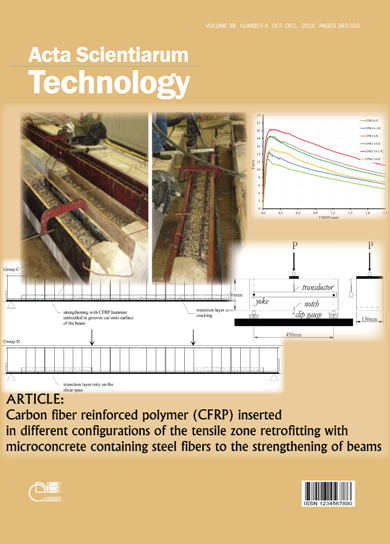<b>Cost-benefit analysis of the construction of different flexible pavement structures considering the axle load and type of binder
DOI:
https://doi.org/10.4025/actascitechnol.v38i4.28497Palavras-chave:
fatigue, asphalt pavement, modified binders.Resumo
The status of Brazilian highways reflects a deficient pavement performance when they are subjected to loadings imposed by heavy traffic. Current legislation, as enacted by Contran (National Traffic Council), has increased the axle weight limit for cargo vehicles by up to 10%. Therefore, the aim of this study was to determine a cost-benefit ratio by using different types of structures, asphalt binders and load intensities. Typical pavements were determined and then analyzed by the software AEMC (SisPav) to obtain the horizontal tensile strain (εt) values at the bottom of the asphalt concrete layer and, later, the NFATIGUE value. It was found that the increase in weight, within values covered by legislation, might result in a reduction of approximately 50% in the NFATIGUE value for the pavement structures analyzed. As for economic impact, the same weight increase caused a mean increase of 120% in the cost of repeated loading on pavement structures (R$ NFATIGUE-1). It was also observed that structures with more robust asphalt concrete layers can provide the best R$ NFATIGUE-1 ratios. The best results for granular materials were found with thinner layers, associated with a thicker coating. The benefits of modified binders were shown by the analyses of the best structural options: both the polymer-modified binder and the rubber asphalt binder offer significant structural and economic improvements to the structure.
Â
Downloads
Downloads
Publicado
Como Citar
Edição
Seção
Licença
DECLARAÇíO DE ORIGINALIDADE E DIREITOS AUTORAIS
Declaro que o presente artigo é original, não tendo sido submetido í publicação em qualquer outro periódico nacional ou internacional, quer seja em parte ou em sua totalidade.
Os direitos autorais pertencem exclusivamente aos autores. Os direitos de licenciamento utilizados pelo periódico é a licença Creative Commons Attribution 4.0 (CC BY 4.0): são permitidos o compartilhamento (cópia e distribuição do material em qualqer meio ou formato) e adaptação (remix, transformação e criação de material a partir do conteúdo assim licenciado para quaisquer fins, inclusive comerciais.
Recomenda-se a leitura desse link para maiores informações sobre o tema: fornecimento de créditos e referências de forma correta, entre outros detalhes cruciais para uso adequado do material licenciado.















